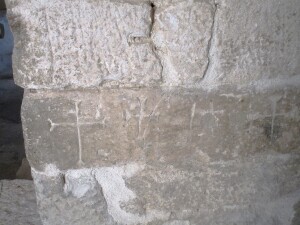So many churches, so little time…
For a city with only ~75,000 inhabitants, Zadar has more than it’s share of churches. During our Free Walking Tour that only cost 40EUR, our guide mentioned that there were many more churches before WW2 but many were destroyed or abandoned at the end of the war. Today there are only 17 churches remaining, of which a few have closed or are being used for other purposes.
Speaking of WW2 and Croatia, a short discussion on what happened here from 6 April 1941 – May 1945. On 6 April 1941 along came Adolf and his boys to add more territory (Yugoslavia) to his holdings. Didn’t take long, by 17 April 1941, it was his and a puppet government was established. Now the civilian killings began.
As we know from other stories about Nazi invasions, there were certain classes of people that were undesirable, add to that Serbs, Slovenes, and Croats. Immediately following the invasion by the Axis, a group of Partisan fighters (Resistance) formed and began causing problems. The Nazi’s tired of this quickly and set up a policy of executing 100 Croats for every 1 Nazi soldier killed; 50 Croats killed for every Nazi soldier wounded. Of course, the standard cleansing of Jews continued in addition to these killings.
Not to be left out, the occupying Italian forces joined in and established concentration camps near Zagreb. These were extermination camps where prisoners were horrifically murdered or simply worked to death. In all, some 30,000 Jews, 30,000 Roma (Gypsies), and 350,000 Serbs were killed between 1941 – 1945.
Enter the Allies. Because Croatia had a deep-water channel (remember) the Allies wanted to make sure the channel and harbor were not used by the Axis powers. So, why not bomb it. And they did, very often. From November 1943 to October 1944, Zadar was bombed over 30 times, almost bi-weekly. During one raid 50 American B-25 medium bombers dropped 90 tons of bombs on the city center. It was obliterated.
Why am I telling you this? Because most, if not all, of the churches we saw were rebuilt after 1945 using debris from burned out buildings. 80% of Zadar was completely in ruin. Keep in mind that after the war, Croatia was part of Yugoslavia, a Communist country until 1948, and a Socialist Republic after that so they were not part of the Marshall Plan – no money for rebuilding.
So, let’s dive into some of those churches. First up was Church of Saint Simeon. St. Simeon is the patron saint of Zadar, known in the New Testament as Simeon the Elder, a man inspired by the Holy Spirit and one of those who were called prophets, came to the Jerusalem temple to take the Child of God in his arms and greet the one who would bring salvation to all peoples.
How his body ended up in Zadar is a lengthy story so let’s just summarize it to say there was a theft involved and maybe some pushing and shoving. Anyway, he’s here in the church interned in a gold covered sarcophagus that is held above the altar by two black angels. There’s also a story about the two black angels but I’ll leave that for you to read. We were fortunate to be here on patron’s day, October 08, when his sarcophagus is opened and his mummified remains can be viewed. Sorry, no cameras are allowed in this church so internet photos will have to do.

 The church was first mentioned around 1180AD but what we see today comes from Gothic adaptations added in the 16th and 17th centuries, with some rebuilding from the late 1940’s.
The church was first mentioned around 1180AD but what we see today comes from Gothic adaptations added in the 16th and 17th centuries, with some rebuilding from the late 1940’s.
Pressing on, we went to the Church of Saint Chrysogonus. A beautifully preserved Romanesque church, consecrated in 1175, originally belonging to a Benedictine monastery that once stood nearby. The front is quite simple, while on the sides have ornate twist columns, and to the rear three semicircular apses, the central one decorated with a gallery. The high altar was built in 1701 by citizens who were spared from plague. In 1717 white marble statues of Zadar’s four patron saints were erected on the altar.
OK, one more church then let’s call it. The Church of Saint Donatus. The Church of St. Donatus is an amazing church from the 9th century and the largest pre-Romanesque structure in Croatia. It’s 27 meters (89’) high and 22 meters (72’) wide, has a cylindrical shape, and a double interior. Today, it mostly used as a venue for concerts. The whole structure is an architectural example of the Carolingian period and it is considered the most significant of its kind in Europe.
The Church of St. Donatus in Zadar is located in the central part of the historic center of the city, not only on the ruins of an ancient forum, but with many structural components (piers, foundation pieces, wall stones, etc.) used from the ruins. These can be easily seen in the building’s walls both internal and external.

When parts of Roman ruins were used, a cross was carved into the wall to denote Christianity and denounce Paganism
Another day down, but many more to go. Next stop, Dubrovnik. For all you Game of Thrones fans, this was the main filming location. The harbor castle was King’s Landing, and the Jesuit Staircase where the famous, “Walk of Shame” occurred.
Mo’ pics from around town…




























